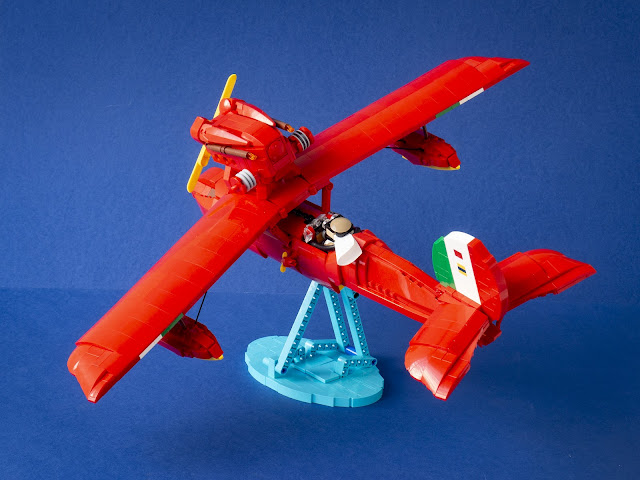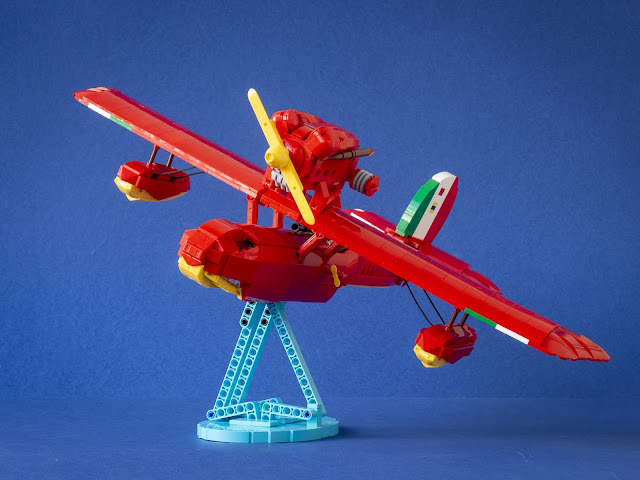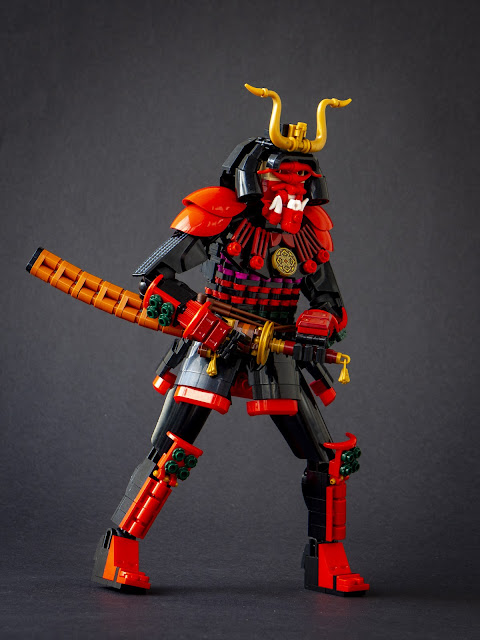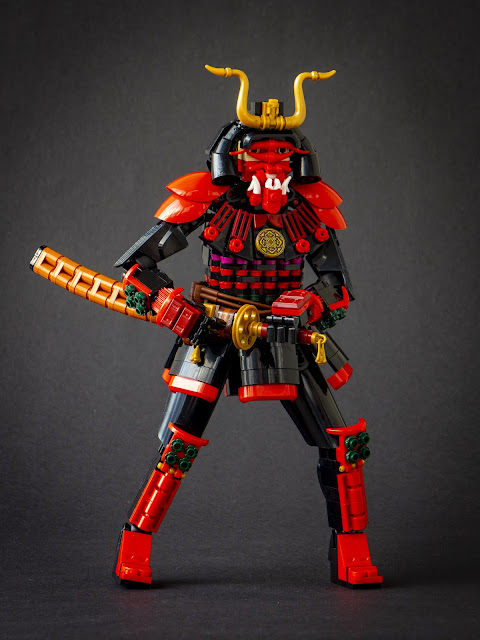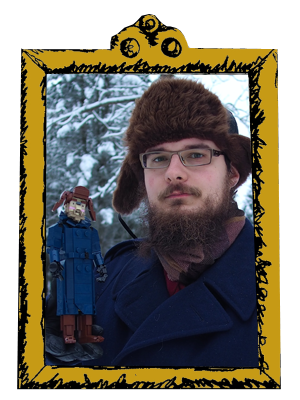I've got no doubt that Hayao Miyazaki's Porco Rosso (1992) is my favourite film. I've built the signature seaplane four times; the first one (cirka 2008) was not documented, but my Brickshelf has a version from December 2009 that can't be much younger. I had the third version from 2015 intact until this summer and even had it in some retrospective exhibits last year. However, I had long realised that its proportions were severely off; I liked its wings, engine and tail, but the fuselage had the bulk of a bomber and I quite never achieved the desired shape of pontoons.
The idea of reshaping this is not new. I'm not sure what it took to finally actualise it after all this year. Nevertheless, I finished this already in July and displayed it in Pii Poo Helsinki event; then it just took some months to photograph it.

This time I took a very close look to the proportions of the actual plane. Savoia is a real manufacturer, and despite it weird looks, the plane is not that far-fetched. As well-know, the closest real-world paragon is Macchi M.33 (two of which were ever built). Monoplane flying boat fighters were very rare, as were ones where the cockpit was situated behind the wing and the engine. Porco's plane (which is a prototype barn-find, too dangerous to fly due to the take-off issues) takes this typology even further with having the wing elevanted above the fuselage; M.33 had the wing connected to the fuselage.

However, no physical Savoia S-21 has ever existed. Ghibli animators drew different proportions for different shots as there was no physical model to reference to; even "official" drawings partly visible in Art of Porco Rosso book feature clearly different measures of the fuselage ratios on the front and back of the wing. The position of the cockpit in relation to the stepped underside varies considerably. This is not an issue when watching the film, but when making a replica, I had to choose the best-looking (and the most common) alternative.
The first part of the design revolved around the so-called Porsche Bow (Wedge 10x2x2) that had been introduced recently in red. Ultimately Markus Rollbünder whom I asked for opinion was right - it was too big and long a piece, I had no hope of embedding the shooting slots with them on the nose. The finished design uses smaller pieces but benefits from other new wedges, which are most prominent in the wing tips. The back of the fuselage was the most challenging part of the whole model and took several re-designs. In addition to being elegant, I wanted to whole model to be sturdy enough for swooshing. This omitted to most free-form techniques, as there had to be continuous skeleton running though the tail. Despite this, the lowest red layer is angled with old finger joints. I'm particularly happy with the obscure Technic steering connector that connects the tail wing; it's very sturdy, and the crowbars are only a cosmetic elements.

I was happy with the old engine, but this enabled some new developing of skill. Porco's engine has these two blob things, likely hiding the V12 pistons, that are rounded on the front and gently sloping and narrowing in the back. I liked their profile in the old engine, but they didn't narrow. Both of the essential parts here, 2x2 corner curved slope did not exist at all in 2015 and the Constraction claw with axle appeared in red only in 2020. Integrating them into the structure took some effort and the result is not entirely gapless, but it flows and has some new aerodynamics. The propellor spins freely.

Again, the pontoons were a challenge, something that I left for the last moment. They still have some "polygons" - the shape is very difficult, especially with the curving border between the red and the yellow. The underside uses the same Constrastion claw, and oh boy it flows beautifully. I think it's more essential, as the top is mostly hidden under the wing. The wings itself are recycled from the 2015 version, though I redesigned the inner structure to house the new connections, and the wing tip is rebuilt with newer pieces.

The previous version has a small Porco in the cockpit and I was not going to skip it here; I wanted to position the plane in mid-air (with a new, more marine base) and having it flying unoccupied would have had catastrophic consequences. While the cape scarf has been recycled from the previous one, the recoloured tan binoculars make sure that Porco Rosso looks better than ever.
-Eero.













